怎么查ACCA成绩?
发布时间:2021-03-12
怎么查ACCA成绩?
最佳答案
ACCA成绩查询有四种途径,分别是:
1. 邮寄—关于考试成绩的唯一官方的正式的通知。每次考试的两个半月后由ACCA总部发出,您收到邮件的时间决定于邮局的工作速度
2.手机查收,ACCA官方会将ACCA考试成绩通过手机短信方式发送到学员
3. 电子邮件(e-mail)-- 您可在myACCA内选择通过email接收考试成绩。更详细的信息。
4. 在线查看考试成绩—所有在ACCA全球网站上登记的考生都可在线查看自己的考试成绩。
下面小编为大家准备了 ACCA考试 的相关考题,供大家学习参考。
(b) How can Maslow’s theory be applied to the motivation of staff? (5 marks)
(b) This theory is based on the idea that the goals of the individual and the organisation can be integrated and that personal satisfaction can be achieved through the workplace. It also assumes that individuals will achieve self-actualisation through their role in assisting the organisation to achieve its objectives. It follows therefore that work is the principal source of satisfaction.
The theory’s practical application is that managers should recognise that subordinates’ needs are always evolving and increasing, so continued attention to increasing the employees’ personal development, opportunities for advancement and recognition of achievement are essential to keep them motivated.
5 A management accounting focus for performance management in an organisation may incorporate the following:
(1) the determination and quantification of objectives and strategies
(2) the measurement of the results of the strategies implemented and of the achievement of the results through a
number of determinants
(3) the application of business change techniques, in the improvement of those determinants.
Required:
(a) Discuss the meaning and inter-relationship of the terms (shown in bold type) in the above statement. Your
answer should incorporate examples that may be used to illustrate each term in BOTH profit-seeking
organisations and not-for-profit organisations in order to highlight any differences between the two types of
organisation. (14 marks)
5 (a) Objectives may be viewed as profit and market share in a profit-oriented organisation or the achievement of ‘value for money’
in a not-for-profit organisation (NFP). The overall objective of an organisation may be expressed in the wording of its mission
statement.
In order to achieve the objectives, long-term strategies will be required. In a profit-oriented organisation, this may incorporate
the evaluation of strategies that might include price reductions, product design changes, advertising campaign, product mix
change and methods changes, embracing change techniques such as BPR, JIT, TQM and ABM. In NFP situations, strategies
might address the need to achieve ‘economy’ through reduction in average cost per unit; ‘efficiency’ through maximisation of
the input:output ratio, whilst checking on ‘effectiveness’ through monitoring whether the objectives are achieved.
The annual budget will quantify the short-term results anticipated of the strategies. These results may be seen as the level of
financial performance and competitiveness achieved. This quantification may be compared with previous years and with
actual performance on an ongoing basis. Financial performance may be measured in terms of profit, liquidity, capital structure
and a range of ratios. Competitiveness may be measured by sales growth, market share and the number of new customers.
In a not-for-profit organisation, the results may be monitored by checking on the effectiveness of actions aimed at the
achievement of the objectives. For instance, the effectiveness of a University may be measured by the number of degrees
awarded and the grades achieved. The level of student ‘drop-outs’ each year may also be seen as a measure of ineffectiveness.
The determinants of results may consist of a number of measures. These may include the level of quality, customer
satisfaction, resource utilisation, innovation and flexibility that are achieved. Such determinants may focus on a range of nonfinancial
measures that may be monitored on an ongoing basis, as part of the feedback information in conjunction with
financial data.
A range of business change techniques may be used to enhance performance management.
Techniques may include:
Business process re-engineering (BPR) which involves the examination of business processes with a view to improving the
way in which each is implemented. A major focus may be on the production cycle, but it will also be applicable in areas such
as the accounting department.
Just-in-time (JIT) which requires commitment to the pursuit of ‘excellence’ in all aspects of an organisation.
Total quality management (TQM) which aims for continuous quality improvement in all aspects of the operation of an
organisation.
Activity based management systems (ABM) which focus on activities that are required in an organisation and the cost drivers
for such activities, with a view to identifying and improving activities that add value and eliminating those activities that do
not add value.
Long-term performance management is likely to embrace elements of BPR, JIT, TQM and ABM. All of these will be reflected
in the annual budget on an ongoing basis.
(ii) Calculate the chargeable gain arising as a consequence of Jan accepting Jumper’s offer. (4 marks)


声明:本文内容由互联网用户自发贡献自行上传,本网站不拥有所有权,未作人工编辑处理,也不承担相关法律责任。如果您发现有涉嫌版权的内容,欢迎发送邮件至:contact@51tk.com 进行举报,并提供相关证据,工作人员会在5个工作日内联系你,一经查实,本站将立刻删除涉嫌侵权内容。
- 2021-01-06
- 2021-03-11
- 2021-03-11
- 2021-03-12
- 2021-04-16
- 2021-05-13
- 2021-01-04
- 2021-05-26
- 2021-05-11
- 2021-04-22
- 2021-05-20
- 2021-10-11
- 2021-03-11
- 2021-04-16
- 2021-05-24
- 2021-05-27
- 2021-01-03
- 2021-04-22
- 2021-03-12
- 2021-06-24
- 2021-12-30
- 2021-03-12
- 2021-04-16
- 2021-03-11
- 2021-12-31
- 2021-03-11
- 2021-12-31
- 2021-02-15
- 2021-04-14
- 2021-03-12